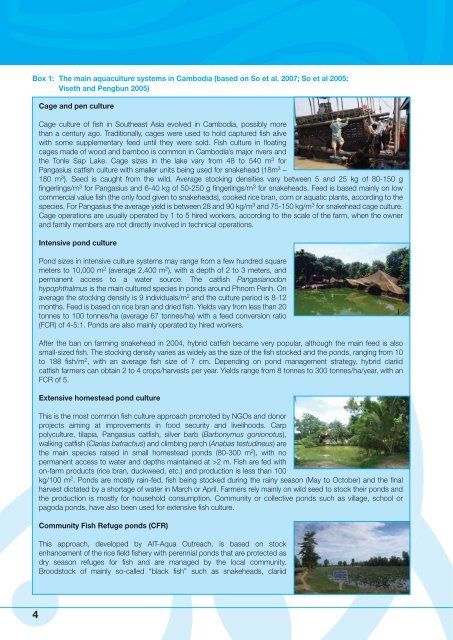Aquaculture for the Poor in Cambodia - World Fish Center
Aquaculture for the Poor in Cambodia - World Fish Center
Aquaculture for the Poor in Cambodia - World Fish Center
You also want an ePaper? Increase the reach of your titles
YUMPU automatically turns print PDFs into web optimized ePapers that Google loves.
Box 1: The ma<strong>in</strong> aquaculture systems <strong>in</strong> <strong>Cambodia</strong> (based on So et al. 2007; So et al 2005;<br />
Viseth and Pengbun 2005)<br />
Cage and pen culture<br />
Cage culture of fish <strong>in</strong> Sou<strong>the</strong>ast Asia evolved <strong>in</strong> <strong>Cambodia</strong>, possibly more<br />
than a century ago. Traditionally, cages were used to hold captured fish alive<br />
with some supplementary feed until <strong>the</strong>y were sold. <strong>Fish</strong> culture <strong>in</strong> float<strong>in</strong>g<br />
cages made of wood and bamboo is common <strong>in</strong> <strong>Cambodia</strong>’s major rivers and<br />
<strong>the</strong> Tonle Sap Lake. Cage sizes <strong>in</strong> <strong>the</strong> lake vary from 48 to 540 m 3 <strong>for</strong><br />
Pangasius catfish culture with smaller units be<strong>in</strong>g used <strong>for</strong> snakehead (18m 3 –<br />
180 m 3 ). Seed is caught from <strong>the</strong> wild. Average stock<strong>in</strong>g densities vary between 5 and 25 kg of 80-150 g<br />
f<strong>in</strong>gerl<strong>in</strong>gs/m 3 <strong>for</strong> Pangasius and 6-40 kg of 50-250 g f<strong>in</strong>gerl<strong>in</strong>gs/m 3 <strong>for</strong> snakeheads. Feed is based ma<strong>in</strong>ly on low<br />
commercial value fish (<strong>the</strong> only food given to snakeheads), cooked rice bran, corn or aquatic plants, accord<strong>in</strong>g to <strong>the</strong><br />
species. For Pangasius <strong>the</strong> average yield is between 28 and 90 kg/m 3 and 75-150 kg/m 3 <strong>for</strong> snakehead cage culture.<br />
Cage operations are usually operated by 1 to 5 hired workers, accord<strong>in</strong>g to <strong>the</strong> scale of <strong>the</strong> farm, when <strong>the</strong> owner<br />
and family members are not directly <strong>in</strong>volved <strong>in</strong> technical operations.<br />
Intensive pond culture<br />
Pond sizes <strong>in</strong> <strong>in</strong>tensive culture systems may range from a few hundred square<br />
meters to 10,000 m 2 (average 2,400 m 2 ), with a depth of 2 to 3 meters, and<br />
permanent access to a water source. The catfish Pangasianodon<br />
hypophthalmus is <strong>the</strong> ma<strong>in</strong> cultured species <strong>in</strong> ponds around Phnom Penh. On<br />
average <strong>the</strong> stock<strong>in</strong>g density is 9 <strong>in</strong>dividuals/m 2 and <strong>the</strong> culture period is 8-12<br />
months. Feed is based on rice bran and dried fish. Yields vary from less than 20<br />
tonnes to 100 tonnes/ha (average 67 tonnes/ha) with a feed conversion ratio<br />
(FCR) of 4-5:1. Ponds are also ma<strong>in</strong>ly operated by hired workers.<br />
After <strong>the</strong> ban on farm<strong>in</strong>g snakehead <strong>in</strong> 2004, hybrid catfish became very popular, although <strong>the</strong> ma<strong>in</strong> feed is also<br />
small-sized fish. The stock<strong>in</strong>g density varies as widely as <strong>the</strong> size of <strong>the</strong> fish stocked and <strong>the</strong> ponds, rang<strong>in</strong>g from 10<br />
to 188 fish/m 2 , with an average fish size of 7 cm. Depend<strong>in</strong>g on pond management strategy, hybrid clariid<br />
catfish farmers can obta<strong>in</strong> 2 to 4 crops/harvests per year. Yields range from 8 tonnes to 300 tonnes/ha/year, with an<br />
FCR of 5.<br />
Extensive homestead pond culture<br />
This is <strong>the</strong> most common fish culture approach promoted by NGOs and donor<br />
projects aim<strong>in</strong>g at improvements <strong>in</strong> food security and livelihoods. Carp<br />
polyculture, tilapia, Pangasius catfish, silver barb (Barbonymus gonionotus),<br />
walk<strong>in</strong>g catfish (Clarias batrachus) and climb<strong>in</strong>g perch (Anabas testud<strong>in</strong>eus) are<br />
<strong>the</strong> ma<strong>in</strong> species raised <strong>in</strong> small homestead ponds (80-300 m 2 ), with no<br />
permanent access to water and depths ma<strong>in</strong>ta<strong>in</strong>ed at >2 m. <strong>Fish</strong> are fed with<br />
on-farm products (rice bran, duckweed, etc.) and production is less than 100<br />
kg/100 m 2 . Ponds are mostly ra<strong>in</strong>-fed, fish be<strong>in</strong>g stocked dur<strong>in</strong>g <strong>the</strong> ra<strong>in</strong>y season (May to October) and <strong>the</strong> f<strong>in</strong>al<br />
harvest dictated by a shortage of water <strong>in</strong> March or April. Farmers rely ma<strong>in</strong>ly on wild seed to stock <strong>the</strong>ir ponds and<br />
<strong>the</strong> production is mostly <strong>for</strong> household consumption. Community or collective ponds such as village, school or<br />
pagoda ponds, have also been used <strong>for</strong> extensive fish culture.<br />
Community <strong>Fish</strong> Refuge ponds (CFR)<br />
This approach, developed by AIT-Aqua Outreach, is based on stock<br />
enhancement of <strong>the</strong> rice field fishery with perennial ponds that are protected as<br />
dry season refuges <strong>for</strong> fish and are managed by <strong>the</strong> local community.<br />
Broodstock of ma<strong>in</strong>ly so-called “black fish” such as snakeheads, clariid<br />
4
















